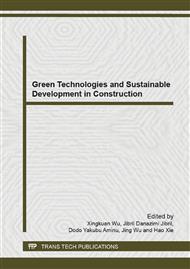[1]
A. Samira, M. Kordjamshidi, H. Pourfallah, Opportunities, Limits & Needs Towards an environmentally responsible architecture, 28th Conference, Lima, Perú (2012).
Google Scholar
[2]
M. Mahdavinejad, M. Bemanian, G. Abolvardi, S. M. Elhamian: Analyzing the state of seismic consideration of architectural non-structural components (ANSCs) in design process (based on IBC). International Journal of Disaster Resilience in the Built Environment, Vol. 3, Iss: 2 (2012).
DOI: 10.1108/17595901211245224
Google Scholar
[3]
M. Mahdavinejad, A. Moradchelleh: Problems and Tendencies of the Development of the Architectural Sciences: Culture Research Aspect, Middle-East J. Sci. Res., 10 (6) (2011) 677-682.
Google Scholar
[4]
M. Mahdavinejad, A. Doroodgar, A. Moradchelleh: The Impacts of Revivalist Trends on the Contemporary Architecture of Iran (1977-2011), Middle-East J. Sci. Res., 11 (2) (2012) 176-183.
Google Scholar
[5]
M. Mahdavinejad, M. Bemanian, M. Hajian, N. Pilechiha: Usage of Indigenous Architectural Patterns for Manufacturing Industrial Housing, Case: Renovation Project of Odlajan of Tehran, Iran, Advanced Materials Research, Vol. 548 (2012) 875-879.
DOI: 10.4028/www.scientific.net/amr.548.875
Google Scholar
[6]
M. Mahdavinejad, S. Ahmadzadeh Siyahrood, M. Ghasempourabadi, M. Poulad, M.: Development of Intelligent Pattern for Modeling a Parametric Program for Public Space (Case study: Isfahan, Mosalla, Iran), Applied Mechanics and Materials, Vols. 220-223 (2012).
DOI: 10.4028/www.scientific.net/amm.220-223.2930
Google Scholar
[7]
M. Mahdavinejad, A. Moradchelleh: The Impact of Family and Social Class on Efficiency of Arts Education and Learning, Middle-East J. Sci. Res., 11 (8) (2012) 1068-1077.
Google Scholar
[8]
M. Mahdavinejad, A. Moradchelleh: Family-Led Method in Art Education and Learning, Case: Tehran, Iran, Middle-East J. Sci. Res., 9 (4) (2011) 554-560.
Google Scholar
[9]
M. Mahdavinejad, S. Matoor, N. Feyzmand, A. Doroodgar: Horizontal Distribution of Illuminance with Reference to Window Wall Ratio (WWR) in Office Buildings in Hot and Dry Climate, Case of Iran, Tehran, Applied Mechanics and Materials, Vols. 110-116 (2012).
DOI: 10.4028/www.scientific.net/amm.110-116.72
Google Scholar
[10]
M. Mahdavinejad, A. Moradchelleh, Family-Led Method in Art Education and Learning, Case: Tehran, Iran, Middle-East J. Sci. Res., 9 (4) (2011) 554-560.
Google Scholar
[11]
M. Mahdavinejad, M. Rezaei Ashtiani, S., Ebrahimi, M., Shamshirband, M. Proposing a Flexible Approach to Architectural Design as a Tool for Achievement Eco-Friendly Multi-Purpose Buildings, Advanced Materials Research, 622-623, (2012) 1856-1859.
DOI: 10.4028/www.scientific.net/amr.622-623.1856
Google Scholar
[12]
M. Nazari, M. Mahdavinejad, M. Bemanian: Protection of High-Tech Buildings Facades and Envelopes with One Sided Nano-Coatings, Advanced Materials Research, 829 (2014) 857-861.
DOI: 10.4028/www.scientific.net/amr.829.857
Google Scholar
[13]
M. Mahdavinejad, M. Mashayekhi, A. Ghaedi, Designing Communal Spaces in Residential Complexes, Procedia - Social and Behavioral Sciences, 51 (2012) 533 – 539.
DOI: 10.1016/j.sbspro.2012.08.169
Google Scholar
[14]
A. Chiesura, The role of urban parks for sustainable city, Landscape and Urban Planning (2004) 129-138.
DOI: 10.1016/j.landurbplan.2003.08.003
Google Scholar
[15]
H. Sanoff, Community participation methods in design and planning, John Wiley& Sons, Inc., (2000).
Google Scholar
[16]
M. Mahdavinejad, M. Amini, Public participation for sustainable urban planning In case of Iran, Procedia Engineering (2011) 405-413.
DOI: 10.1016/j.proeng.2011.11.2032
Google Scholar
[17]
M.A. Khoshooee, M.H. Motevali Haghighi, M.R. Pourjafar, M.S.M. Mofidi, Sustainable Architecture: Conception to Realization, 5th SASTech 2011, Khavaran Higher-education Institute, Mashhad, Iran (2011).
Google Scholar
[18]
S. Afrasiabian, M. Mahdavinejad, N. Badri, Nature as a source of sustainable design in architecture of oriental countries (case study: traditional architecture of Iran), Archi-Cultural Translations through the Silk Road, 2nd International Conference, Mukogawa Women's Univ., Nishinomiya, Japan (2012).
Google Scholar
[19]
J. Hugé, L. Hens, Sustainability assessment of Poverty Reduction Strategy Papers, Impact Assessment and Project Appraisal, 25(4) (2007).
DOI: 10.3152/146155107x233471
Google Scholar
[20]
M. Mezzi, P. Verducci, J. Jun LIU, Innovative Systems for a Sustainable Architecture and Engineering, IABSE Symposium, Shanghai: Metropolitan Habitats and Infrastructure, International Association for Bridge and Structural Engineering (2004).
DOI: 10.2749/222137804796302310
Google Scholar
[21]
A. Khiabanian, M. Jodeiri Abbasi, Sustainable House in Iran's Desert, Journal of Basic and Applied Scientific Research, 2(9) (2012) 8877-8885.
Google Scholar
[22]
Green Building Rating System for New Construction & Major Renovations (LEED-NC), Version 2. 1 (2002), Information on http: /www. usgbc. org/Docs/LEEDdocs/LEED_RS_v2-1. pdf.
Google Scholar
[23]
M. Mahdavinejad, K. Javanroudi, L. H. Rafsanjani, Investigating Condensation Role in Defects and Moisture Problems in Historic Buildings Case study: Varamin Friday mosque in Iran, World Journal of Science, Technology and Sustainable Development 10 (4) (2010).
DOI: 10.1108/wjstsd-02-2013-0017
Google Scholar
[24]
M. Mahdavinejad, M. Bemanian, S. F. Farahani, A. Tajik, P. Taghavi: Association of Mental Health and Work Environment in Hospital Workers, International Journal of Academic Research, 3 (1) (2011) 171-173.
Google Scholar
[25]
M. Mahdavinejad, S. R. Ashtiani, Dilemma of Energy Efficiency and Moisture Condensation Damages in Eco-Friendly Buildings, Case: Great Mosque of Saveh, European Journal of Scientific Research, 107 (4) (2013) 46 – 552.
Google Scholar
[26]
M. Mahdavinejad, L. H. Rafsanjani, M. Rasoolzadeh, M. Nazari: Challenges Regarding to Usage of Nanostructured Materials in Contemporary Building Construction, Advanced Materials Research, 829 (2014) 426-430.
DOI: 10.4028/www.scientific.net/amr.829.426
Google Scholar
[27]
M. Mahdavinejad, M. Nazari, S. Khazforoosh: Commercialization Strategies for Industrial Applications of Nanomaterials in Building Construction, Advanced Materials Research, 829 (2014) 879-883.
DOI: 10.4028/www.scientific.net/amr.829.879
Google Scholar


